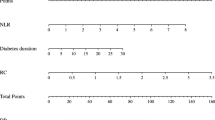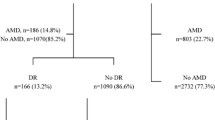Abstract
Purpose
Previous studies have yielded conflicting results regarding whether serum lipid levels are associated with retinal hard exudates in diabetic retinopathy. The majority of studies have assessed hard exudates only as a dichotomous trait (presence vs. absence) and included limited numbers of African Americans (AA). The purpose of this study was to determine if there are any associations between serum lipid levels and hard exudates in AA with type 2 diabetes (T2D).
Methods
890 AA participants with T2D were enrolled from 5 sites. Macular fundus photographs were graded by masked ophthalmologist investigators. Hard exudate areas were measured using a semi-automated algorithm and ImageJ software. Multivariate regression models were used to determine the association between serum lipid levels and (1) presence of hard exudate and (2) area of hard exudate.
Results
Presence of hard exudates was associated with higher total cholesterol [(odds ratio (OR) = 1.08, 95 % confidence interval (CI) 1.03–1.13, P = 0.001)] and higher low-density lipoprotein (LDL) cholesterol (OR = 1.08, 95 % CI 1.03–1.14, P = 0.005) in models controlling for other risk factors. Hard exudate area was also associated with both higher total and LDL cholesterol levels (P = 0.04 and 0.01, respectively) in multivariate models controlling for other risk factors.
Conclusions
Higher total and LDL cholesterol were associated with the presence of hard exudates and a greater hard exudate area in AA with T2D. This information can be used to counsel diabetic patients regarding the importance of lipid control to decrease the risk of macular hard exudates.


Similar content being viewed by others
References
King RC, Dobree JH, Kok D, Foulds WS, Dangerfield WG (1963) Exudative diabetic retinopaty. Spontaneous changes and effects of a corn oil diet. Br J Ophthalmol 47:666–672
Aiken LS, West SG (1991) Multiple regression : testing and interpreting interactions. Sage Publications, Newbury Park
Moses LE, Emerson JD, Hosseini H (1984) Analyzing data from ordered categories. N Engl J Med 311:442–448. doi:10.1056/NEJM198408163110705
Bhandari M, Lochner H, Tornetta P 3rd (2002) Effect of continuous versus dichotomous outcome variables on study power when sample sizes of orthopaedic randomized trials are small. Arch Orthop Trauma Surg 122:96–98. doi:10.1007/s004020100347
Roy MS, Klein R (2001) Macular edema and retinal hard exudates in African Americans with type 1 diabetes: the New Jersey 725. Arch Ophthalmol 119:251–259
Klein R, Sharrett AR, Klein BE, Moss SE, Folsom AR, Wong TY, Brancati FL, Hubbard LD, Couper D (2002) The association of atherosclerosis, vascular risk factors, and retinopathy in adults with diabetes : the atherosclerosis risk in communities study. Ophthalmology 109:1225–1234
Klein R, Marino EK, Kuller LH, Polak JF, Tracy RP, Gottdiener JS, Burke GL, Hubbard LD, Boineau R (2002) The relation of atherosclerotic cardiovascular disease to retinopathy in people with diabetes in the Cardiovascular Health Study. Br J Ophthalmol 86:84–90
Penman AHH, Papavasileiou E, James M, Idowu O, Riche DM, Fernandez M, Brauner S, Smith SO, Hoadley S, Richardson C, Vazquez V, Chi C, Andreoli C, Husain D, Chen CJ, Sobrin L (2015) Risk factors for proliferative diabetic retinopathy in African Americans with type 2 diabetes. Ophthalmic Epidemiol 23(2):88–93
Penman A, Hoadley S, Wilson JG, Taylor HA, Chen CJ, Sobrin L (2015) P-selectin plasma levels and genetic variant associated with diabetic retinopathy in African Americans. Am J Ophthalmol 159:1152–1160.e2. doi:10.1016/j.ajo.2015.03.008
American Diabetes Association (2003) Report of the expert committee on the diagnosis and classification of diabetes mellitus. Diabetes Care 26(Suppl 1):S5–S20
Davoudi S, Papavasileiou E, Roohipoor R, Cho H, Kudrimoti S, Hancock H, Hoadley S, Andreoli C, Husain D, James M, Penman A, Chen CJ, Sobrin L (2016) Optical coherence tomography characteristics of macular edema and hard exudates and their association with lipid serum levels in type 2 diabetes. Retina. doi:10.1097/IAE.0000000000001022
Chalam KV, Bressler SB, Edwards AR, Berger BB, Bressler NM, Glassman AR, Grover S, Gupta SK, Nielsen JS (2012) Retinal thickness in people with diabetes and minimal or no diabetic retinopathy: Heidelberg Spectralis optical coherence tomography. Invest Ophthalmol Vis Sci 53:8154–8161. doi:10.1167/iovs.12-10290
Lovestam-Adrian M, Svendenius N, Agardh E (2000) Contrast sensitivity and visual recovery time in diabetic patients treated with panretinal photocoagulation. Acta Ophthalmol Scand 78:672–676
Viera AJ, Garrett JM (2005) Understanding interobserver agreement: the kappa statistic. Fam Med 37:360–363
Landis JR, Koch GG (1977) The measurement of observer agreement for categorical data. Biometrics 33:159–174
Bland JM, Altman DG (1986) Statistical methods for assessing agreement between two methods of clinical measurement. Lancet 1:307–310
Bland JM, Altman DG (1999) Measuring agreement in method comparison studies. Stat Methods Med Res 8:135–160
Bland JM, Altman DG (2003) Applying the right statistics: analyses of measurement studies. Ultrasound Obstet Gynecol 22:85–93. doi:10.1002/uog.122
Klein BE, Moss SE, Klein R, Surawicz TS (1991) The Wisconsin Epidemiologic Study of Diabetic Retinopathy. XIII. Relationship of serum cholesterol to retinopathy and hard exudate. Ophthalmology 98:1261–1265
Chew EY, Klein ML, Ferris FL 3rd, Remaley NA, Murphy RP, Chantry K, Hoogwerf BJ, Miller D (1996) Association of elevated serum lipid levels with retinal hard exudate in diabetic retinopathy. Early Treatment Diabetic Retinopathy Study (ETDRS) Report 22. Arch Ophthalmol 114:1079–1084
van Leiden HA, Dekker JM, Moll AC, Nijpels G, Heine RJ, Bouter LM, Stehouwer CD, Polak BC (2002) Blood pressure, lipids, and obesity are associated with retinopathy: the hoorn study. Diabetes Care 25:1320–1325
Miljanovic B, Glynn RJ, Nathan DM, Manson JE, Schaumberg DA (2004) A prospective study of serum lipids and risk of diabetic macular edema in type 1 diabetes. Diabetes 53:2883–2892
Idiculla J, Nithyanandam S, Joseph M, Mohan VA, Vasu U, Sadiq M (2012) Serum lipids and diabetic retinopathy: a cross-sectional study. Indian J Endocrinol Metab 16:S492–S494. doi:10.4103/2230-8210.104142
Sasaki M, Kawasaki R, Noonan JE, Wong TY, Lamoureux E, Wang JJ (2013) Quantitative measurement of hard exudates in patients with diabetes and their associations with serum lipid levels. Invest Ophthalmol Vis Sci 54:5544–5550. doi:10.1167/iovs.13-11849
Sachdev N, Sahni A (2010) Association of systemic risk factors with the severity of retinal hard exudates in a north Indian population with type 2 diabetes. J Postgrad Med 56:3–6. doi:10.4103/0022-3859.62419
Lujan BJ, Wang F, Gregori G, Rosenfeld PJ, Knighton RW, Puliafito CA, Danis RP, Hubbard LD, Chang RT, Budenz DL, Seider MI, Knight O (2008) Calibration of fundus images using spectral domain optical coherence tomography. Ophthalmic Surg Lasers Imaging 39:S15–S20
Barr DB (1995) Estimation of optic disc size. Br J Ophthalmol 79:298–299
Chihara E, Chihara K (1994) Covariation of optic disc measurements and ocular parameters in the healthy eye. Graefes Arch Clin Exp Ophthalmol 232:265–271
Jonas JB, Gusek GC, Guggenmoos-Holzmann I, Naumann GO (1988) Variability of the real dimensions of normal human optic discs. Graefes Arch Clin Exp Ophthalmol 226:332–336
Chew EY, Davis MD, Danis RP, Lovato JF, Perdue LH, Greven C, Genuth S, Goff DC, Leiter LA, Ismail-Beigi F, Ambrosius WT (2014) The effects of medical management on the progression of diabetic retinopathy in persons with type 2 diabetes: the Action to Control Cardiovascular Risk in Diabetes (ACCORD) Eye Study. Ophthalmology 121:2443–2451. doi:10.1016/j.ophtha.2014.07.019
Gupta A, Gupta V, Thapar S, Bhansali A (2004) Lipid-lowering drug atorvastatin as an adjunct in the management of diabetic macular edema. Am J Ophthalmol 137:675–682. doi:10.1016/j.ajo.2003.11.017
Panagiotoglou TD, Ganotakis ES, Kymionis GD, Moschandreas JA, Fanti GN, Charisis SK, Malliaraki NE, Tsilimbaris MK (2010) Atorvastatin for diabetic macular edema in patients with diabetes mellitus and elevated serum cholesterol. Ophthalmic Surg Lasers Imaging 41:316–322. doi:10.3928/15428877-20100430-04
Harris MI, Klein R, Cowie CC, Rowland M, Byrd-Holt DD (1998) Is the risk of diabetic retinopathy greater in non-Hispanic blacks and Mexican Americans than in non-Hispanic whites with type 2 diabetes? A U.S. population study. Diabetes Care 21:1230–1235
Klein R, Klein BE, Neider MW, Hubbard LD, Meuer SM, Brothers RJ (1985) Diabetic retinopathy as detected using ophthalmoscopy, a nonmydriatic camera and a standard fundus camera. Ophthalmology 92:485–491
Wong TY, Klein R, Islam FM, Cotch MF, Folsom AR, Klein BE, Sharrett AR, Shea S (2006) Diabetic retinopathy in a multi-ethnic cohort in the United States. Am J Ophthalmol 141:446–455. doi:10.1016/j.ajo.2005.08.063
Varma R, Bressler NM, Doan QV, Gleeson M, Danese M, Bower JK, Selvin E, Dolan C, Fine J, Colman S, Turpcu A (2014) Prevalence of and risk factors for diabetic macular edema in the United States. JAMA Ophthalmol 132:1334–1340. doi:10.1001/jamaophthalmol.2014.2854
Sattar N, Preiss D, Murray HM, Welsh P, Buckley BM, de Craen AJ, Seshasai SR, McMurray JJ, Freeman DJ, Jukema JW, Macfarlane PW, Packard CJ, Stott DJ, Westendorp RG, Shepherd J, Davis BR, Pressel SL, Marchioli R, Marfisi RM, Maggioni AP, Tavazzi L, Tognoni G, Kjekshus J, Pedersen TR, Cook TJ, Gotto AM, Clearfield MB, Downs JR, Nakamura H, Ohashi Y, Mizuno K, Ray KK, Ford I (2010) Statins and risk of incident diabetes: a collaborative meta-analysis of randomised statin trials. Lancet 375:735–742. doi:10.1016/S0140-6736(09)61965-6
Ucgun NI, Yildirim Z, Kilic N, Gursel E (2007) The importance of serum lipids in exudative diabetic macular edema in type 2 diabetic patients. Ann N Y Acad Sci 1100:213–217. doi:10.1196/annals.1395.021
Acknowledgements
The Jackson Heart Study is supported by contracts HHSN268201300046C, HHSN268201300047C, HHSN268201300048C, HHSN268201300049C, HHSN268201300050C from the National Heart, Lung, and Blood Institute and the National Institute on Minority Health and Health Disparities.
Author information
Authors and Affiliations
Corresponding author
Ethics declarations
Funding
This study was supported by the following grants: American Diabetes Association Clinical Translational Research Award 1-11-CT-51, Alexandria, VA. Research to Prevent Blindness Career Development Award, New York City, NY; Harvard Catalyst | The Harvard Clinical and Translations Science Center Faculty Fellowship, Boston, MA; Massachusetts Lions Eye Research Fund, Abington, MA; Eleanor and Miles Shore Fellowship, Boston, MA; Sara Elizabeth O’Brien Trust, Boston, MA; Research to Prevent Blindness William & Mary Greve Special Scholar Award; Alcon Research Institute Young Investigator Award. The sponsors had no role in the design or conduct of this research.
Conflict of interest
All authors certify that they have no affiliations with or involvement in any organization or entity with any financial interest or non-financial interest in the subject matter or materials discussed in this manuscript. None of the authors have any proprietary interests or conflicts of interest related to this submission.
Ethical approval
All procedures performed in this study were in accordance with the ethical standards of the institutional research committee and with the 1964 Helsinki Declaration and its later amendments.
Informed consent
Informed consent was obtained from all individual participants included in the study.
Additional information
This submission has not been published anywhere previously and is not simultaneously being considered for any other publication.
Evangelia Papavasileiou and Samaneh Davoudi contributed equally to this work.
Rights and permissions
About this article
Cite this article
Papavasileiou, E., Davoudi, S., Roohipoor, R. et al. Association of serum lipid levels with retinal hard exudate area in African Americans with type 2 diabetes. Graefes Arch Clin Exp Ophthalmol 255, 509–517 (2017). https://doi.org/10.1007/s00417-016-3493-9
Received:
Revised:
Accepted:
Published:
Issue Date:
DOI: https://doi.org/10.1007/s00417-016-3493-9




